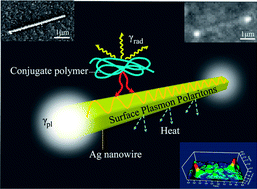Effective excitation and control of guided surface plasmon polaritons in a conjugated polymer–silver nanowire composite system†
Abstract
This study demonstrates a novel light-emitting

* Corresponding authors
a
Key Laboratory for Polymeric Composite and Functional Materials of Ministry of Education, School of Chemistry and Chemical Engineering, Sun Yat-sen University, Guangzhou, China
E-mail:
cescxd@mail.sysu.edu.cn, ceszmq@mail.sysu.edu.cn
b State Key Laboratory of Optoelectronic Materials and Technologies, School of Physics and Engineering, Sun Yat-sen University, Guangzhou 510275, China
This study demonstrates a novel light-emitting

 Please wait while we load your content...
Something went wrong. Try again?
Please wait while we load your content...
Something went wrong. Try again?
W. Zhang, Y. Chen, C. Hu, Y. Zhang, X. Chen and M. Q. Zhang, J. Mater. Chem. C, 2013, 1, 1265 DOI: 10.1039/C2TC00568A
To request permission to reproduce material from this article, please go to the Copyright Clearance Center request page.
If you are an author contributing to an RSC publication, you do not need to request permission provided correct acknowledgement is given.
If you are the author of this article, you do not need to request permission to reproduce figures and diagrams provided correct acknowledgement is given. If you want to reproduce the whole article in a third-party publication (excluding your thesis/dissertation for which permission is not required) please go to the Copyright Clearance Center request page.
Read more about how to correctly acknowledge RSC content.
 Fetching data from CrossRef.
Fetching data from CrossRef.
This may take some time to load.
Loading related content
